XO sauce is the most valuable Cantonese condiment, with various umami flavors concentrated from dried scallops, Jinhua ham, and dried shrimps.
XO sauce got its name from the XO (extra-old) cognac. It is believed the chef developed the recipe at the Peninsular Hotel, a famous hotel in Hong Kong. The name is a misnomer since it does not contain cognac, but this type of description of the food is popular in Chinese cuisine to portray the high quality. It simply means it is a valuable and expensive sauce like an XO cognac.
Most people buy their XO Sauce, which is costly. In addition, you have to settle with a toned-down flavor than the homemade XO sauce that uses higher quality ingredients. If you make it yourself, you can enjoy it at a fraction of the cost.
Note: This post may contain affiliate links. Please read my privacy policy for more info. I may receive commissions for purchases made through links in this post. As an Amazon Associate, I earn from qualifying purchases.
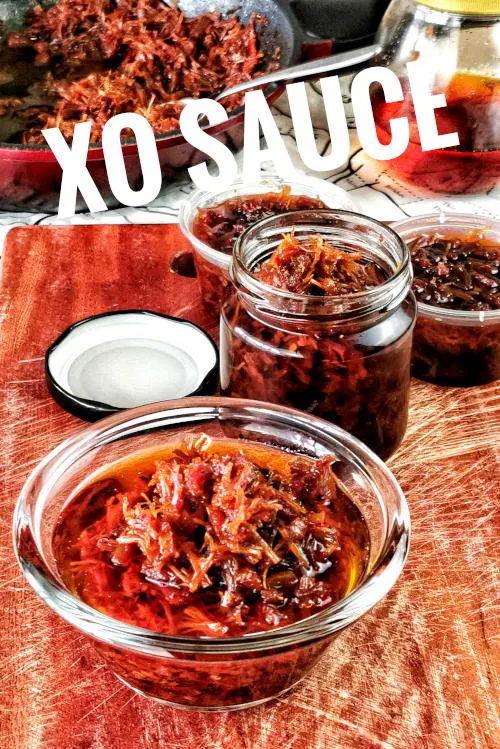
How to make XO sauce
XO sauce has a rich umami taste with a complex sweet, smoky, and salty flavor. The taste of this condiment will dominate any dish. Dried scallops, Jinhua ham, and dried shrimp are deep-fried to accentuate the flavor, then season with wine and soy sauce. The sauce is finally cooked down to a semi-dried, chunky, highly concentrated, umami-packed, relish-like ‘sauce’ suspended in oil.
1. Key ingredients for XO sauce
There are no set recipes for XO sauce. However, most recipes consist of a triumvirate of universal ingredients: Jinhua ham, dried scallops, and dried shrimp. This XO sauce recipe is no exception.
Jinhua ham (金華火腿)
Jinhua ham is the specialty Chinese ham that originated from the city of Jinhua (also romanized as Kinhwa), located in the center of Zhejiang province in eastern China. It is a type of dry-cured ham which is very salty with an intense bacony taste. Jinhua ham may not be available at some places, and the Smithfield ham or bacon is the closest substitute.
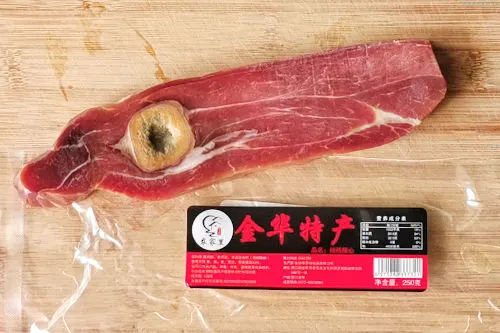
Dried scallops (conpoy, 乾貝 / 江瑶柱)
The dried scallop is a popular ingredient in Cantonese cuisine, often used to prepare superior stock and other expensive banquet dishes. You need to soak it for a prolonged period to soften it as it is pretty hard. It has a rich umami taste and smells reminiscent of other sea-cured meat like dried shrimp. Th highly concentrated flavor is mainly from amino acids such as glycine, alanine, and glutamic acid.
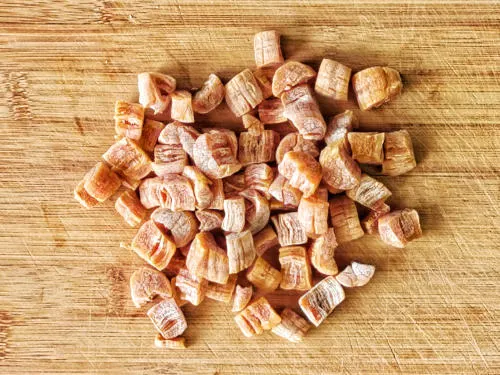
Dried shrimp 虾米
Dried shrimp is another dried seafood similar to dried scallops but is more widely used due to its lower price compared to dried scallops. It is sun-dried shrimp that shrunk to thumbnail size. It is like scallops, but with its distinct umami flavor. Aga n, you need to soak it before use, but the soaking time required is shorter than dried scallops.
Other dried seafood ingredients are used in some XO sauce recipes that I do not use here. For example, you can consider including dried fish and dried anchovies if you like.
Dried shrimp is also used in making sambal tumis, a chili sauce that is hugely popular in Malaysia. You can get the sambal sauce recipe here.
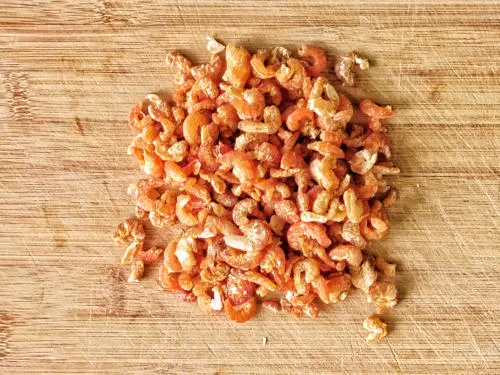
2. Secondary ingredients for XO sauce
There are three secondary ingredients for XO sauce: shallots, garlic, and red chilies.
Shallot and garlic are the aromatics that give the sauce the body, while the red chilies provide spiciness.
Cut the shallot and the garlic manually into small dice. I prefer chopped garlic to crushed garlic because mashed garlic will burn quickly while deep-frying.
Similarly, cut the red chili into small pieces. Aga n, remove the seeds if you do not want the sauce to taste too spicy.
3. Soak, steam, and cut the dried ingredients
You should start the preparation by soaking the dried ingredients in advance.
Dried scallops
Since dried scallop is quite hard, you need to soak it at least for a few hours or overnight. It takes a long time to steam it until soft if you do not soak it long enough.
The time required depends on how long it has been soaked and the size of the scallops. After soaking, it takes about 45 minutes of steaming to soften the scallops until you can easily shred them into individual strips. You can pick one scallop and shred it from time to time to decide when you should stop steaming the rest.
Once softened, remove and let it cool until you can manage with your hands. Next, shred each dried scallop into the individual fine strips. It will take some time to do it, and the process is faster if the scallop has turned soft and tender.
Jinhua ham
Cut the Jinhua ham into half-inch thick slices and steam with the dried scallops. Steaming will soften the ham as it is too hard to cut into small dice.
The ham will soften in twenty minutes. However, I steam the ham together with the dried scallops and remove it much longer than fifteen minutes which will not affect the outcome of the ham.
Remove the ham and then cut it into small dice.
Dried shrimp
Dried shrimp is relatively softer than dried scallops, so you only need to soak it for fifteen minutes. Steaming is not necessary. After soaking, drain the dried shrimp and then chop it into the size of rice grains.
4. Deep-fry the ingredients to bring out the flavor
The next step of preparing the XO sauce is to deep-fry the main ingredients.
I use about 600ml of vegetable oil, such as peanut oil. It seems a lot of oil, but it is necessary because:
- We need to deep-fry the shredded scallops, Jinhua ham, dried shrimp, shallot, and garlic.
- The oil is required to preserve the sauce during storage, preferably sufficient to cover all the ingredients to prevent oxidation so that the sauce is stable and can be kept for a long time.
- The oil has a rich flavor. Therefore, you do not need extra oil for cooking or flavoring any dishes if the recipe includes XO sauce.
Here are the steps:
- Place the oil in a large wok or a large skillet and bring it to medium-high heat, about 150°C/300°F.
- Since the scallops, shrimp, and onions contain water, there will be plenty of bubbles created, and the level of oil will rise rapidly the moment you add them into the hot oil. Therefore, it is essential to reduce to moderate heat if the oil swells and overflow from the wok.
- Start with deep-frying the scallops, Jinhua ham, and dried shrimp, followed by the onion and garlic. I would suggest deep-frying the scallops, ham, and shrimp separately because they have different water content. Hence, they require different duration to deep-fried until become light golden, slightly crispy, and dry. The time required is generally around five minutes for each one, but depends on how much water remains after draining and steaming. Therefore, it is best not to set a fixed time but to observe the texture. All these three items are done when they look dry, slightly crispy, and light brown. The texture should be similar to lightly-fried bacon.
- Once you have finished deep-frying one of them, remove with a wire mesh strainer to drain the oil. Then, place it in a separate pan and continue to deep-fry the next item.
- Once you finish deep-frying the scallops, ham, and shrimp, continue to do the same for the shallots, garlic, and chilies. Add the shallots to the oil and deep-fry for about five minutes, followed by the garlic. You should add the garlic later because it has lower moisture content and tends to change color quickly. Continue to deep-fry until the color of the shallots and garlic starts to turn golden. Next, add the red chilies and fry for another minute, then turn off the heat.
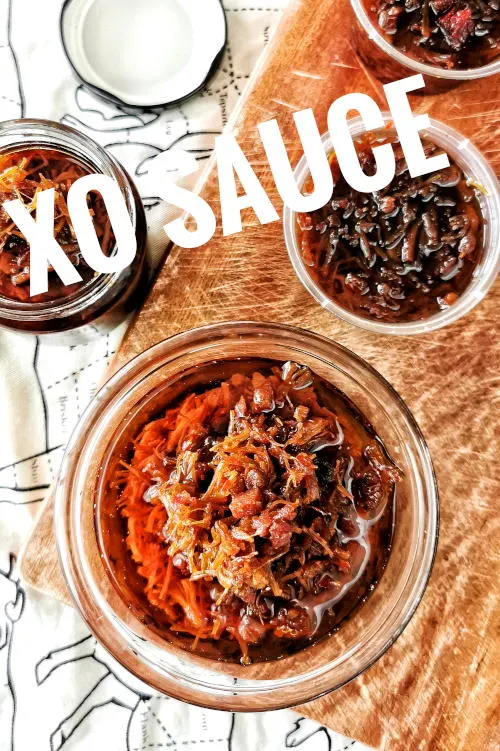
5. Season the sauce heavily and cook it until dry
You need to season the XO sauce heavily since it is meant to be a condiment and part of the seasoning for stir-frying. You wi l expect it to be too salty by tasting it alone, but it is OK.
- Place all the fried scallops, ham, and shrimp in a saucepan or skillet. Season it with Shaoxing wine, light soy sauce, oyster sauce, sugar, and the leftover extract of the ham and scallops after steaming. You can use either white or brown sugar.
- Bring it to a boil and mix well. Now return these ingredients to the wok that contains the fried shallot, garlic, and chilies.
- Now you can add some chili powder if you like it spicy. The chili powder also makes the chili oil look redder and more appealing.
- Continue to simmer it over low heat until all the water has evaporated.
The XO sauce is ready!
Note: Some XO sauce recipes include fish sauce and sesame oil. I prefer to leave them out as the ingredients’ flavor in this recipe is already sufficient.
Tips to make the best XO Sauce
There are a few tips I want to share to increase the odd to make it a success:
- You can substitute the Shaoxing wine with dry sherry.
- Use country ham, virginia ham or bacon if Jinhua ham is unavailable.
- You need to soak and steam the dried scallops long enough. If in any instant after making the sauce and find that the dried scallops are too hard, you can salvage it by adding a small amount of water to the sauce and simmer it until it is soft enough. In this case, make sure all the added water is evaporated, as there should not be any water in the finishing product.
- You can change the quantity of the dried scallops, ham, and dried shrimp. Some people also like to add some salted fish and dried anchovies.
- The sauce should be savory and salty, as it is meat to eat with other items, not to be served alone.
- You decide how many chili peppers to use based on the level of spiciness you want. I like to add some chili powder which gives a better color to the sauce. Kashmiri chili powder has a bright red color which is perfect for this purpose. You can also use red pepper flakes as the alternative.
How to use XO sauce
XO sauce has multiple usages, especially in Cantonese cooking. You can refer to this article which details how to use XO sauce to prepare a few traditional dishes.
Some common usage includes preparing fried rice, noodles, and topping for various dishes. You can also sprinkle the sauce on bok choy and use it as a dipping sauce.
Lastly, if you do not intend to make it, you can purchase XO sauce from most Asian grocery stores. Lee Ku Kee is a well-known brand of XO sauce.
Storage
You can refrigerate the XO sauce in an airtight container for up to one month. After that, make s e there is sufficient oil to submerge all the solid ingredients and fill up only when it returns to room temperature. You can also keep it frozen if you intend to keep it longer.
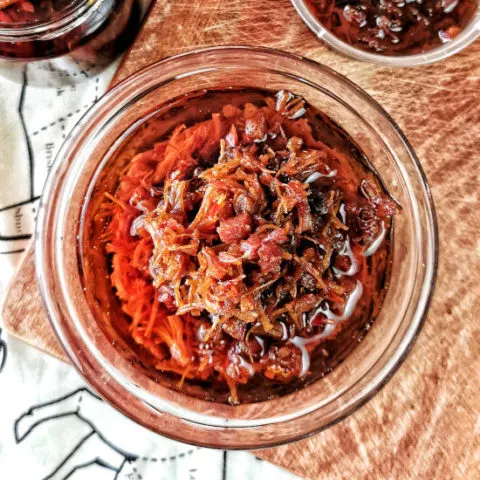
How to make XO sauce - a comprehensive guide
XO sauce is the most valuable Cantonese condiment, made with expensive ingredients with an intense savory flavor concentrated from dried scallop, Jinhua ham, and dried shrimps.
Ingredients
Ingredients A
- 150g dried scallop
- 100g Jinhua ham
- 100g dried shrimp
- 600ml vegetable oil
Ingredients B
Ingredients C
- 200g shallot
- 60g garlic
- 3 large red chili
- 2 tbsp chili powder
Instructions
Soaking and steaming
- Soak the dried scallop overnight. Then, steam for 45 minutes to soften the scallop. Remove and let it cool. Next, shred each dried scallop into the individual fine strips.
- Cut the Jinhua ham into half-inch thick slices and steam together with the dried scallop. Then cut the ham into small dice.
- Soak the dried shrimp for fifteen minutes. Drain the dried shrimp and then chop it into the size of rice grains.
Deep-frying
- Heat the oil to about 150°C/300°F.
- Start with deep-frying the scallop, Jinhua ham, and dried shrimp one after another. Remove each one before deep-fry the next one. Each of them should be deep-fried until slightly golden, slightly crispy, and dry.
- Cut the shallot and the garlic into small dice.
- Cut the red chili into small pieces and remove the seeds.
- Add the shallots to the oil and deep-fry for about five minutes, then add the garlic and continue until the color turns golden. Next, add the red chilies and fry for another minute, then turn off the heat.
Season the sauce
- Place the fried scallop, ham, and shrimp in a pan. Season them with Shaoxing wine, light soy sauce, oyster sauce, sugar, and leftover extract after steaming the ham and scallop.
- Bring it to a boil and mix well. Now pour it back to the wok and mix with the fried shallot, garlic, and chilies.
- Add some chili powder if you like it spicy.
- Continue to simmer it over low heat until all the water has evaporated.
- The XO sauce is ready!
Recommended Products
As an Amazon Associate and member of other affiliate programs, I earn from qualifying purchases.
Nutrition Information:
Yield: 10 Serving Size: 1Amount Per Serving: Calories: 741Total Fat: 66gSaturated Fat: 8gTrans Fat: 1gUnsaturated Fat: 53gCholesterol: 64mgSodium: 1299mgCarbohydrates: 18gFiber: 2gSugar: 5gProtein: 20g

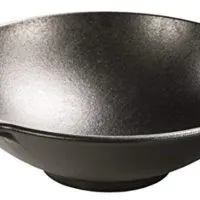
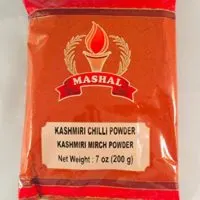
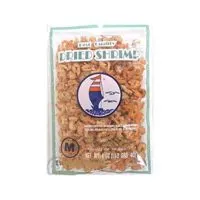

KP Kwan
Sunday 5th of September 2021
Hi, this is KP Kwan. I am happy to see you in this comment area, as you have read through my recipe. I am glad to reply to any questions and comments as soon as possible.